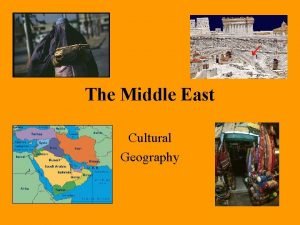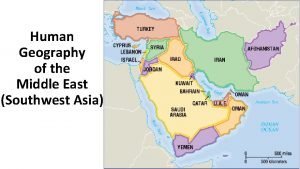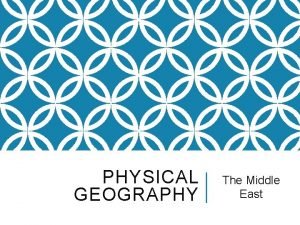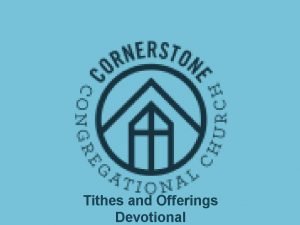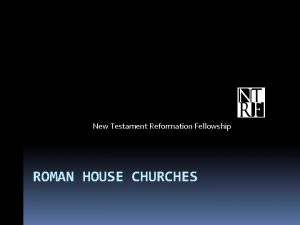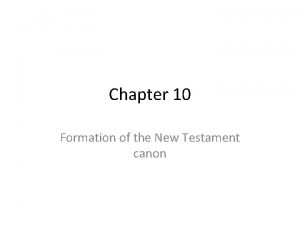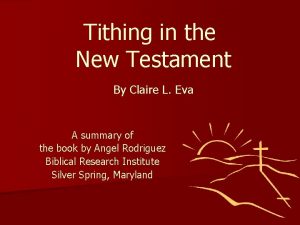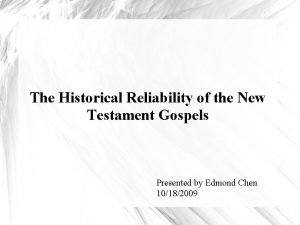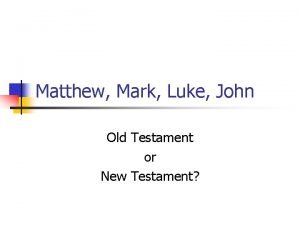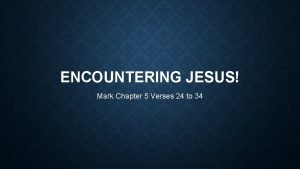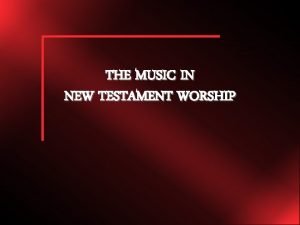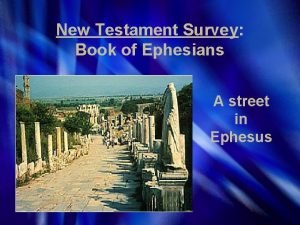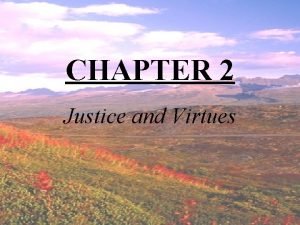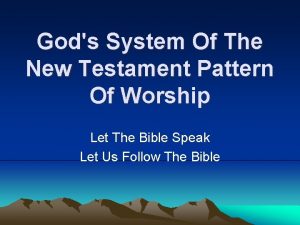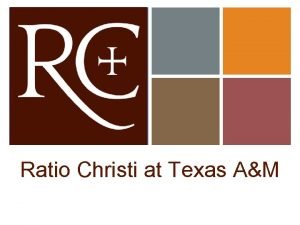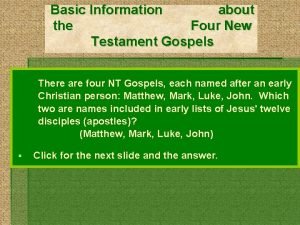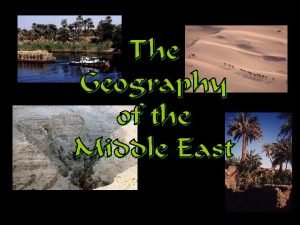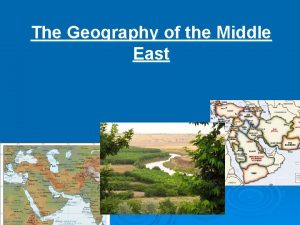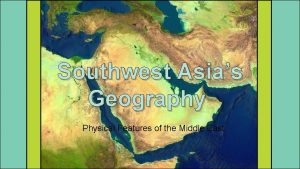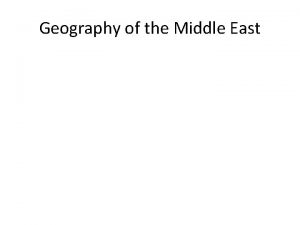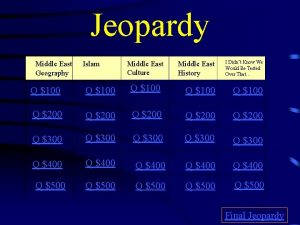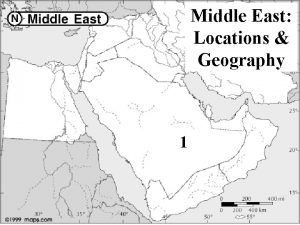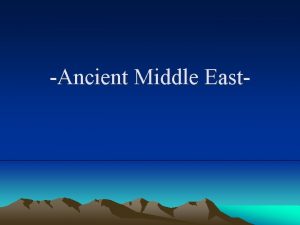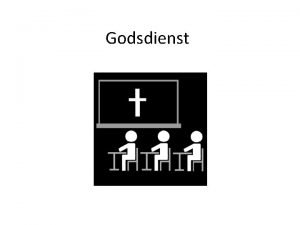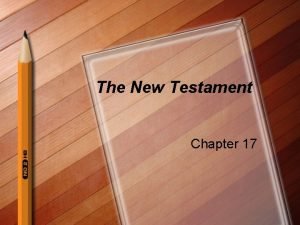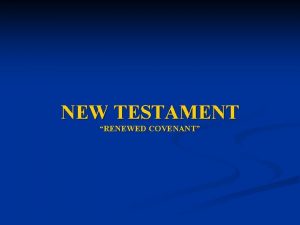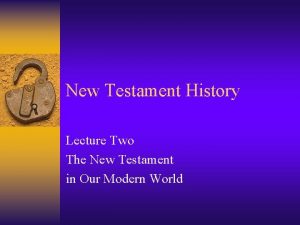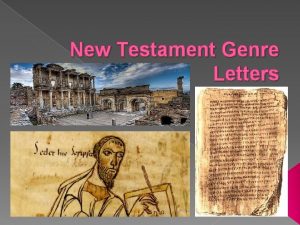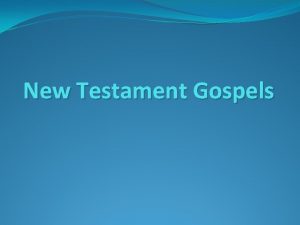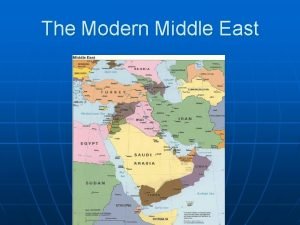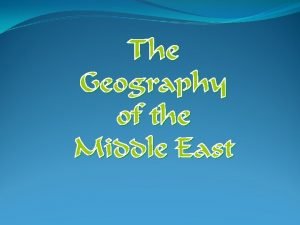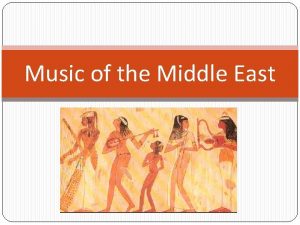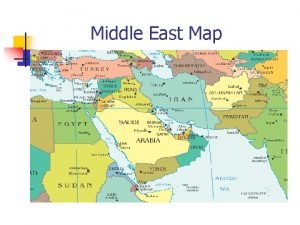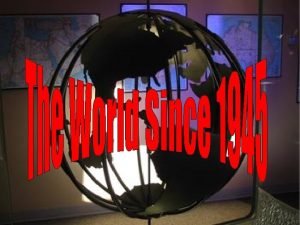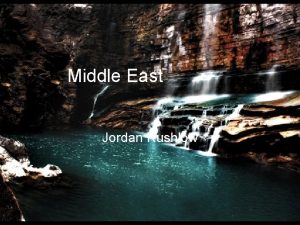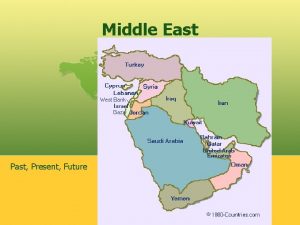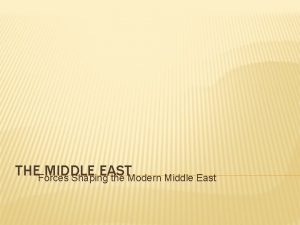Geography of the New Testament MIDDLE EAST land
































- Slides: 32

Geography of the New Testament

MIDDLE EAST: land east of the Persian Gulf & northward through Red Sea. Very important geographical are in biblical times (and today!) NT focuses mainly on Palestine (Jesus) & Asia Minor (Paul)

PALESTINE • Home to three of world’s greatest religions: Christianity, Islam, Judaism. All consider Palestine “holy land. ” Jerusalem main city. • The “center of the universe” in ancient world • Would be the “main stage” for all of the events in the four gospels and the life of Jesus.

ASIA MINOR • Modern-day Turkey; north of Lebanon & Syria • Would be main focus of Paul’s missionary journeys.

OVERVIEW OF THE GOSPELS

THREE DIVISIONS OF THE NEW TESTAMENT: 1. The Gospels 2. Acts of the Apostles & Pauline Epistles 3. Hebrews, General Epistles & Revelation A total of 27 books

THREE DIVISIONS OF THE NEW TESTAMENT: 1. The Gospels • Matthew • Mark • Luke • John

THREE DIVISIONS OF THE NEW TESTAMENT: 2. Acts of the Apostles & Pauline Epistles • • • Acts of the Apostles Romans 1 & 2 Corinthians Galatians Ephesians Philippians Colossians 1 & 2 Thessalonians 1 & 2 Timothy Titus Philemon

THREE DIVISIONS OF THE NEW TESTAMENT: 3. Hebrews, General Epistles & Revelation • • • Hebrews James 1 & 2 Peter 1, 2, & 3 John Jude Revelation

MAJOR EVENTS IN NT HISTORY HIGHLIGHTS: • 167 -164 BCE – Antiochus IV persecutes the Jews & Maccabean revolt • 40 BCE – Herod rules as Roman-appointed king in Palestine; Caesar takes throne • 6/4 BCE – Jesus is born • 27 -29 CE – Ministry of John the Baptist • 29 -33 CE – Ministry of Jesus • 33 -35 CE – Paul’s conversion • 47 -56 CE – Paul’s missionary journeys

MAJOR EVENTS IN NT HISTORY HIGHLIGHTS: • 64 CE – Rome is burned & Christians are persecuted • 66 -70 CE – Gospel of Mark is written • 66 -73 CE – Jewish revolt against Rome, Jerusalem & temple are destroyed • 80 -85 CE – Gospel of Matthew is written • 80 -90 CE – Gospel of Luke/Acts is written • 90 -100 CE – Gospel of John is written

OVERVIEW OF THE FOUR GOSPELS: Word “gospel” from Greek “evangelion, ” meaning GOOD NEWS Gospel writers are not: modern biographers, who compile historically accurate accounts of past events Gospel writers ARE: believers who present narratives of Jesus as it relates to Christian faith.

OVERVIEW OF THE FOUR GOSPELS: SYNOPTIC GOSPELS • First three gospels (Matthew, Mark Luke) • Share much of the same material • Widely accepted that Mark was the first gospel written, & Matthew & Luke drew on Mark as their basic narrative source. • All three follow same sequence of events.

OVERVIEW OF THE FOUR GOSPELS: SYNOPTIC GOSPELS • “Q” – a second major source to account for material found in Matthew & Luke but not in Mark (from “quelle, ” German for “source”). • Source primarily sayings of Jesus; very little narrative. GOSPEL OF JOHN • Quite different from Synoptics • 90% of John’s material is unique to itself.

GOSPEL OF MARK

GENERAL FACTS ABOUT GOSPEL OF MARK Written around 66 -70 CE – author unknown. The “Messianic Secret” – Jesus is portrayed a sort of “hidden savior” whose identity is revealed only through his suffering & death. Jesus is universally misunderstood, rejected by his own people & condemned by the Romans.

GENERAL FACTS ABOUT GOSPEL OF MARK No birth narrative account – focus is on adult, human Jesus. Negative view of those close to Jesus – disciples are oblivious to who he is; listeners fail to grasp his teachings. They don’t understand! Miracles – esp. healings – are big in Mark

First part of Mark has Jesus in Galilee – here he performs miracles & teaches. Here Jesus is seen as powerful (casting out demons, healing the sick, etc. ) Second half of Mark occurs south in Judea & Jerusalem, where Jesus is rejected & killed.

FIVE DIVISIONS OF MARK’S GOSPEL: • 1: 1 -13 – Prelude to Jesus’ public ministry • 1: 14 -8: 26 – Galilean ministry inaugurating God’s kingdom • 8: 27 -10: 52 – Journey from Caesarea Philippi to Jerusalem • 11: 1 -15: 47 – the Jerusalem Ministry • 16: 1 -8 - Postlude

MARK 1: 1 -13: PRELUDE TO JESUS’ PUBLIC MINISTRY John the Baptist – a desert nomad Mark sees as being sent to “prepare the way” for Jesus’ first appearance in Mark is to John, who recognizes him (one of the few) & baptizes him. Vss. 12 -13 – Jesus endures temptation in the desert. Following this, he is prepared for ministry.

MARK 1: 14 -8: 26: THE GALILEAN MINISTRY - HIGHLIGHTS Vs. 15 – central to Mark’s purpose & objective: The time is fulfilled, and the kingdom of God has come near; Repent and believe in the Good News. For Mark, the end of history was imminent. Therefore, the message of Jesus was urgent to those who read Mark’s words. Greek word for “immediately”, “at once" used 40 times – highlights immediacy of Mark’s message.

MARK 1: 14 -8: 26: THE GALILEAN MINISTRY - HIGHLIGHTS JESUS AS HEALER • One of Jesus’ most important functions in Mark – bringing relief to the afflicted. • Some examples: 1: 40 -42 2: 1 -12 3: 1 -6 5: 25 -34 5: 21 -24, 35 -43 • Jesus as healer reveals his humanity & God’s concern for the well-being of people.

MARK 1: 14 -8: 26: THE GALILEAN MINISTRY - HIGHLIGHTS CONFLICT STORIES Mark devotes much space to Jesus’ numerous conflicts w/ four groups: Pharisees – didn’t like his lax attitude toward law Scribes – also didn’t like his take on the law Sadducees – priests who thought Jesus was disrupting tenuous relationship w/Rome Herodians – thought Jesus was directly challenging rule of King Herod

MARK 1: 14 -8: 26: THE GALILEAN MINISTRY - HIGHLIGHTS CONFLICT STORIES Two classic confrontations: 2: 23 -3: 7 – redefining the Sabbath 7: 1 -8, 14 -23 – redefining what “defiles” Why the conflict? ? ? • They saw Jesus as a threat to their power • They saw Jesus as perverting the Jewish faith • They saw Jesus as inciting the people • They saw Jesus as disturbing the tenuous peace with Rome

Chpt. 8 marks a pivotal point in Mark’s gospel For the first time, Jesus is recognized as the Messiah (8: 27 -29) For Mark, people couldn’t know Jesus’ identity as Messiah until after he completed his mission. Focuses turns to necessity of Jesus’ suffering – and, by association, the suffering of those who choose to follow him.

THE JERUSALEM MINISTRY Chpt. 11: vs. 1 ff – Jesus welcomed into Jerusalem with regal greeting – Waving palm branches, spreading cloaks on ground – Sing praises hailing Jesus as descendant of King David – “Hosanna!” During stay in Jerusalem, Jesus alienates Roman & Jewish authorities: – Turns tables on moneychangers in temple (11: 15 -19) – Knocking the scribes (12: 38 -40)

THE JERUSALEM MINISTRY Chpt. 13 – Jesus predicts Roman destruction of Jerusalem & temple; and to remain faithful in time of tribulation Probably reflected on events happening when Mark was written – Jewish revolt of late 60’s CE & Rome’s destruction of Jerusalem.

JESUS’ PASSION THE LAST SUPPER (14: 12 -25) • Accounted for in all Synoptic gospels • Gathering of Jesus & disciples to celebrate the Passover meal of Jewish custom. • Jesus gives this meal new significance, with the bread as his body & the wine as his blood. • Jesus betrayed by Judas, one of his disciples, handed over to the authorities “with a kiss. ”

JESUS’ PASSION IN THE GARDEN OF GETHESEMANE & TRIAL • Shows Jesus at one of his most human moments • In his prayer, refers to God as “Abba, ” an endearing term a child calls their parent. • Jesus tried by high priests. 14: 61 -62 – only gospel where Jesus fully accepts his messianic identity. • Unable to find evidence to condemn him, they take him to Pilate on charges of treason.

JESUS’ PASSION BEFORE PILATE & THE CRUCIFIXION • Pilate is pictured by Mark as reluctant to condemn Jesus & does so only after being pressured. • Crucifixion was a common method of torture/killing by Roman empire. • Jesus dies of asphyxiation – the body gets so tired hanging that one can’t breathe.

THE EMPTY TOMB All gospels have Mary Magdalene as the first one to find the empty tomb. Jesus does not make a post-resurrection appearance in Mark – may have to do with Mark’s belief that Jesus’ return was tied to Jewish revolt of his time. Gospel ends with two different endings (? ): – 16: 8 b – 16: 9 -17 – Possibly added to gospel in early 2 nd century

SUMMARY • First Gospel written around 66 -70 CE – time of Jewish revolt & Jerusalem’s destruction • Used as a primary source in Matthew & Luke • “Messianic secret” – those around him don’t get it! • “Immediately” • Miracles/healings very big in Mark
 North american
North american Ethnic groups in the middle east
Ethnic groups in the middle east Human geography of the middle east
Human geography of the middle east Physical geography of middle east
Physical geography of middle east Encouraging words for offering and tithes
Encouraging words for offering and tithes House churches in the new testament
House churches in the new testament Tithe in new testament
Tithe in new testament Encountering jesus in the new testament answer key
Encountering jesus in the new testament answer key Encountering jesus in the new testament
Encountering jesus in the new testament The formation of the new testament canon
The formation of the new testament canon Tithing in the new testament
Tithing in the new testament Reliability of new testament
Reliability of new testament Test: the general epistles new testament survey
Test: the general epistles new testament survey New testament reformation fellowship
New testament reformation fellowship Matthew mark luke john books of the bible
Matthew mark luke john books of the bible Encountering jesus in the new testament
Encountering jesus in the new testament Titus in the bible summary
Titus in the bible summary Instrumental music in new testament worship
Instrumental music in new testament worship New testament survey book
New testament survey book God-given virtues that direct us to our loving, triune god.
God-given virtues that direct us to our loving, triune god. 27 new testament books
27 new testament books New testament pattern of worship
New testament pattern of worship New testament canon
New testament canon Doctrinal mastery passages
Doctrinal mastery passages Choose life new testament
Choose life new testament Four new testament gospels
Four new testament gospels Horizontal movement of air
Horizontal movement of air East is east and west is west
East is east and west is west What are landforms
What are landforms High rocky land usually with steep sides
High rocky land usually with steep sides Middle east latitude
Middle east latitude Why is it called middle east
Why is it called middle east Inlet of indian ocean between africa and asia
Inlet of indian ocean between africa and asia

